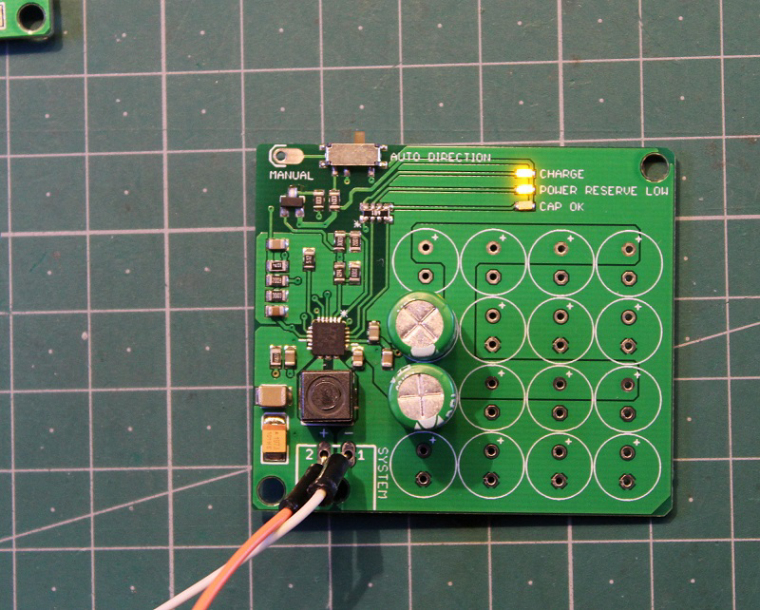How best to find the "best" small solar panel of a particular size?
-
@NeverDie Interesting find. Could you post the product links instead of the order links? Order links can't be visited without being logged in as the user who made the order.
@mfalkvidd said in How best to find the "best" small solar panel of a particular size?:
@NeverDie Interesting find. Could you post the product links instead of the order links? Order links can't be visited without being logged in as the user who made the order.
I can't post a link now to the good ones, because it looks as though they are no longer being sold. I had posted links before that worked. Believe me, no one is sorrier about this than me, because I want to order more of them.
-
I just today started using a smart diode between the solar panel and the supercap. Voltage drop across it is a mere 0.03v, so I assume that means more power is faster transfered from the panel into the supercap.
-
I just today started using a smart diode between the solar panel and the supercap. Voltage drop across it is a mere 0.03v, so I assume that means more power is faster transfered from the panel into the supercap.
-
@NeverDie said in How best to find the "best" small solar panel of a particular size?:
smart diode
what's that?
@gohan said in How best to find the "best" small solar panel of a particular size?:
@NeverDie said in How best to find the "best" small solar panel of a particular size?:
smart diode
what's that?
It's this:

It better approximates an "ideal diode" than an actual diode does. So, it behaves like a diode, but the voltage drop is much less. I measured the reverse current leakage on it, and it's about 1ua, which is higher than some of the best diodes, but not bad.
-
TI also makes a single integrated "smart diode": http://www.ti.com/product/SM74611
which I've also tried. However, it has a bigger voltage drop, so I don't like it as much. Also, TI's chip is more expensive. -
Back to the OP, here's a screen scrape of what had been the "good" small solar cells:

Here's a closeup photo of one:

It may not show so well in the photo, but what I think may be key is that it wasn't pieced together out of scrap solar cell fragments (like the "bad" one was) but rather appears to be a single piece. So, that may be a clue on what to look for in the future.
-
Here's a schematic for the ideal diode that is pictured above:
-
Not sure. There's probably a risk of UV damage to the epoxy, but that's just a guess.
At the moment, I'm focused on indoor use, which is a largely ignored category. I think outdoors is easier because, well, it's a lot brighter. For instance, novicit (above) reported "The solar panel is from China, Ebay, 110mmx70mm, 5V, 1.25W. The panel works great also. It reaches 4V in the smallest amount of light, and 5.45V (no load) in modest indirect light. In fact, it will fully recharge the supercapacitor in the morning before the sun even rises above the horizon, just from the sky brightening. (From the ~20% overnight discharged state.) It seems to charge a fully empty supercap in ~10 minutes under average light."
-
If anyone has a favorite buck converter chip, or one they want to recommend, I could possibly make a PCB for it and post it on mysensors.org. Suggestions anyone?
-
I received the 0.7v to 3.0v boost converter module from Aliexpress whose link I had posted earlier above. Can anyone identify the chip which is on it?

-
I received the 0.7v to 3.0v boost converter module from Aliexpress whose link I had posted earlier above. Can anyone identify the chip which is on it?

@NeverDie it is a ME2188 from MicrOne
http://www.sz-hxdz.com/uploadfile/pdf/201605111221584282.pdf -
Anyone interested in super capacitors.
I'm working on a backup super capacitor storage board. It connects directly to the power rail and charges and balances super capacitors bank. When and if power fails the board steps in and provides power to the circuit.

It is based on LTC3110 super capacitor bi-directional charging IC. -
Anyone interested in super capacitors.
I'm working on a backup super capacitor storage board. It connects directly to the power rail and charges and balances super capacitors bank. When and if power fails the board steps in and provides power to the circuit.

It is based on LTC3110 super capacitor bi-directional charging IC. -
Anyone interested in super capacitors.
I'm working on a backup super capacitor storage board. It connects directly to the power rail and charges and balances super capacitors bank. When and if power fails the board steps in and provides power to the circuit.

It is based on LTC3110 super capacitor bi-directional charging IC.@ceech
Isn't it more economic to buy just one much larger supercap, with say 16x the Farads of the supercaps in your photo? Or does a capacitor bank have some other advantages besides just higher Farads?By the way, have you found supercaps that you like which also have very low self-discharge? I've been using leakage as a proxy for self-discharge--because self-discharge data is hard to come by--but they are actually defined differently.
-
why use supercaps on an arduino tha consumes so low current? that caps will not discharge during night,when solar panels are not producing energy.?

@Tmaster They will slowly discharge. And depending on quality discharge times can vary a lot. The ones I'm using have a leaking current of 6uA.
Of course not always is a super capacitor a suitable replacement for a battery but where batteries are not available, suitable or safe, super capacitors can take their place. They also have some advantages - high cycle life of more than 100.000 cycles comes to mind.
